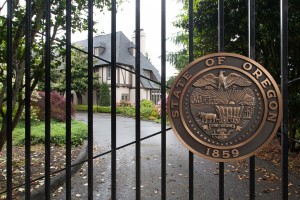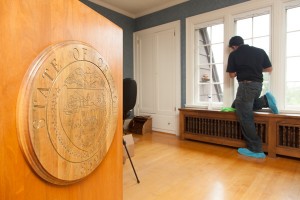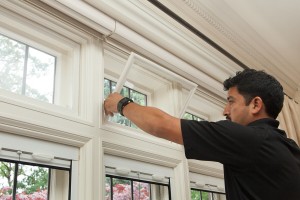
(photo courtesy of Neil Kelly)
Mahonia Hall, the Oregon governor’s mansion, was nicknamed Pneumonia Hall by past gubernatorial residents because of the building’s energy inefficiency. Built in 1924 for hop farmer Thomas Livesley by Ellis Lawrence, founder of the University of Oregon School of Architecture, it’s beautiful and grand. But also drafty and cold. Last year, First Lady Cylvia Hayes decided to do something about that. She and Gov. John Kitzhaber wanted comfort and to save Oregonians money on heating bills.
Upgrading a building on the National Register of Historic Places can be tricky, especially when it comes to windows. Hayes and the governor knew that in order to upgrade the building they would need to take care with the beautiful, but drafty, historic single-pane windows. Replacing them wasn’t an option.

(photo courtesy of Neil Kelly)
Indow Windows, a four-year-old business in Portland, provided the answer with 31 thermal, acrylic window inserts that press into the interior of the window frames. Since they require no hardware, Indow Windows are intended to leave historic windows intact. Neil Kelly Home Performance air-sealed cracks, added insulation and installed more than 100 new LED light bulbs. All materials and time were donated so no cost to Oregon taxpayers. The difference was immediate. “We can keep the thermostat lower than we could have a year ago with these improvements,” said Oregon’s first lady.

(photo courtesy of Neil Kelly)
The final numbers aren’t in, but Mahonia Hall’s energy bills have been lower each month vis-à-vis the same month the previous year. That underscores what a study commissioned by the Preservation Green Lab and funded by the National Park Service found: there’s no need to replace windows to reap energy savings. Upgrading windows with insulating materials like storms leads to substantial energy savings across a variety of climates – almost on a par with high-performance replacement windows at a fraction of the cost.
Mahonia Hall– originally called the T.A. Livesley House and renamed Mahonia in 1988 after the Oregon state flower, Mahonia Aquifolium was one of the first public buildings in the pipeline to benefit from the State Building Innovation Lab created in 2012 to reduce energy consumption in public buildings throughout Oregon. Not only is the mansion now more livable and comfortable, but Hayes said it reflects her and Gov. Kitzhaber’s commitment to energy efficiency.

(photo courtesy of Neil Kelly)
“In the governor’s 10-year energy plan, one of our key strategies is to meet future demand for electricity through energy conservation,” she said. “And we really wanted to make sure that we were walking the talk at Mahonia Hall as well. We use this beautiful old place a lot for state business. It’s often the very first taste of Oregon that out-of-state and even out-of-country guests get and we wanted to make sure we were practicing what we preach with energy efficiency here.”

